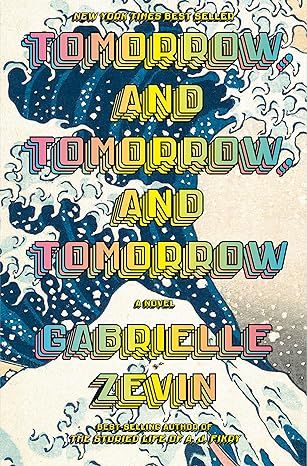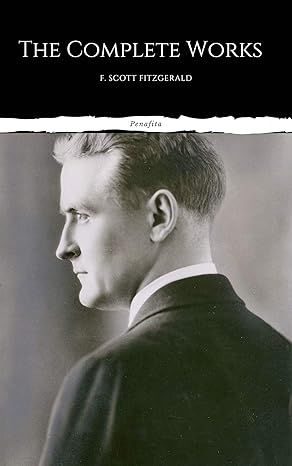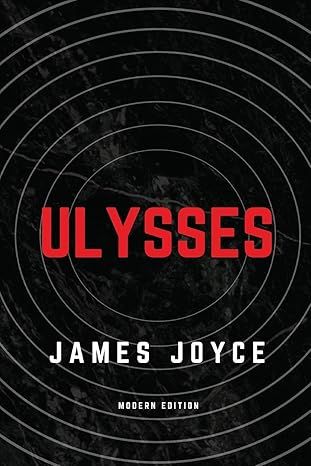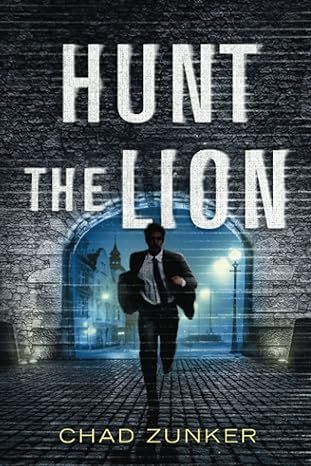Tomorrow, and Tomorrow, and Tomorrow: A novel
4.4
-
95,875 ratings
NEW YORK TIMES BEST SELLER • Sam and Sadie—two college friends, often in love, but never lovers—become creative partners in a dazzling and intricately imagined world of video game design, where success brings them fame, joy, tragedy, duplicity, and, ultimately, a kind of immortality. It is a love story, but not one you have read before.
"Delightful and absorbing." —The New York Times • "Utterly brilliant." —John Green
One of the Best Books of the Year: The New York Times, Entertainment Weekly, TIME, GoodReads, Oprah Daily
From the best-selling author of The Storied Life of A. J. Fikry: On a bitter-cold day, in the December of his junior year at Harvard, Sam Masur exits a subway car and sees, amid the hordes of people waiting on the platform, Sadie Green. He calls her name. For a moment, she pretends she hasn’t heard him, but then, she turns, and a game begins: a legendary collaboration that will launch them to stardom.
These friends, intimates since childhood, borrow money, beg favors, and, before even graduating college, they have created their first blockbuster, Ichigo. Overnight, the world is theirs. Not even twenty-five years old, Sam and Sadie are brilliant, successful, and rich, but these qualities won’t protect them from their own creative ambitions or the betrayals of their hearts.
Spanning thirty years, from Cambridge, Massachusetts, to Venice Beach, California, and lands in between and far beyond, Gabrielle Zevin’s Tomorrow, and Tomorrow, and Tomorrow examines the multifarious nature of identity, disability, failure, the redemptive possibilities in play, and above all, our need to connect: to be loved and to love.
Kindle
$13.99
Available instantly
Audiobook
$0.00
with membership trial
Hardcover
$14.71
Paperback
$17.10
Ships from
Amazon.com
Payment
Secure transaction
ISBN-10
0593321200
ISBN-13
978-0593321201
Print length
416 pages
Language
English
Publisher
Knopf
Publication date
July 04, 2022
Dimensions
6.4 x 1 x 9.5 inches
Item weight
1.48 pounds
Popular highlights in this book
There is a time for any fledgling artist where one’s taste exceeds one’s abilities. The only way to get through this period is to make things anyway.
Highlighted by 20,331 Kindle readers
This is what time travel is. It’s looking at a person, and seeing them in the present and the past, concurrently. And that mode of transport only worked with those one had known a significant time.
Highlighted by 13,680 Kindle readers
You’re incredibly gifted, Sam. But it is worth noting that to be good at something is not quite the same as loving it.
Highlighted by 9,693 Kindle readers
Product details
ASIN :
B09JBCGQB8
File size :
5746 KB
Text-to-speech :
Enabled
Screen reader :
Supported
Enhanced typesetting :
Enabled
X-Ray :
Enabled
Word wise :
Enabled
Editorial reviews
One of the Best Books of the Year: The New York Times, TIME, Buzzfeed, Entertainment Weekly, Oprah Daily, Slate, Self.com, Bookpage, Kirkus, SheReads, GoodReads, Goop, and The What List
A New York Times Notable Book of the Year • A Jimmy Fallon Book Club Pick • A Time Must-Read Book of the Year • A Washington Post Notable Work of Fiction • BookPage Best Fiction of the Year
"Delightful and absorbing...Zevin burns precisely zero calories arguing that game designers are creative artists of the highest order. Instead, she accepts that as a given, and wisely so, for the best of them plainly are...Expansive and entertaining...Dozens of Literary Gamers will cherish the world she’s lovingly conjured. Meanwhile, everyone else will wonder what took them so long to recognize in video games the beauty and drama and pain of human creation." —Tom Bissell, The New York Times
"A tour de force... A moving demonstration of the blended power of fiction and gaming....Zevin describes herself as 'a lifelong gamer.' That level of experience could very well have produced a story of hermetically sealed nostalgia impenetrable to anyone who doesn’t still own a copy of 'Space Invaders.' But instead, she’s written a novel that draws any curious reader into the pioneering days of a vast entertainment industry too often scorned by bookworms. And with the depth and sensitivity of a fine fiction writer, she argues for the abiding appeal of the flickering screen." —Ron Charles, The Washington Post
“Whatever its subject, when a novel is powerful enough, it transports us readers deep into worlds not our own. That's true of Moby Dick, and it's certainly true of Tomorrow, and Tomorrow, and Tomorrow, which renders the process of designing a great video game as enthralling as the pursuit of that great white whale….There are…smart ruminations here about cultural appropriation, given that the game, Ichigo, is inspired by Japanese artist Hokusai's famous painting The Great Wave at Kanagawa….It's a big, beautifully written novel about an underexplored topic, that succeeds in being both serious art and immersive entertainment.” —Maureen Corrigan, NPR’s Fresh Air
"Engrossing....Though it contains plenty of nostalgia for the pioneer age of 1990s game design, this isn’t primarily a novel of nerdy insider references....Videogames happen to be the medium by which [Zevin's characters] best express themselves and share in each other’s life." —Sam Sacks, The Wall Street Journal
“Woven throughout [Tomorrow, and Tomorrow, and Tomorrow] are meditations on originality, appropriation, the similarities between video games and other forms of art, the liberating possibilities of inhabiting a virtual world, and the ways in which platonic love can be deeper and more rewarding—especially in the context of a creative partnership—than romance.” —The New Yorker
"Tomorrow, and Tomorrow, and Tomorrow is a celebration of the narratives, in video games and in life, that reinforce just how important connection really is. In following Sam and Sadie’s journey from Massachusetts to California and into the imagined worlds of their games, Zevin writes the most precious kind of love story." —Annabel Gutterman, Time
“The story of three brilliant kids who found a videogame company, this book is about so much more—friendship, love, loyalty, violence in America and the magic of invented worlds. Gorgeous.” —Kim Hubbard, People
"Zevin is a great writer who makes you care deeply about her characters....Tomorrow, and Tomorrow, and Tomorrow resonated with me for personal reasons, but I think Zevin’s exploration of partnership and collaboration is worth reading no matter who you are. Even if you’re skeptical about reading a book about video games, the subject is a terrific metaphor for human connection." —Bill Gates
"You don’t have to be a gamer to appreciate the pulsing heart of this best-seller: In a story spanning three decades and references from Oregon Trail to Macbeth, Gabrielle Zevlin has written a modern, definitive story about work, love, and friends for whom you’d do and risk everything." —Keely Weiss and Halie Lesavage, Harper’s Bazaar
“A remarkably absorbing portrait of friendship, identity, and the urge to create something beautiful, whether it be on the page or in pixels….Zevin…clearly knows her way around an RPG, but it's the analog intimacy of Tomorrow's wise, sensitive storytelling that stays.” —Leah Greenblatt, Entertainment Weekly
"I’ve never played a video game in my life, and I was sucked into this book like it was Halo and I was a socially awkward tween in 2001. Really, this isn’t just a book for people who understand life through the pixels, but for people who understand life through stories." —Jenny Singer, Glamour
Read more
Sample
Chapter 1
Before Mazer invented himself as Mazer, he was Samson Mazer, and before he was Samson Mazer, he was Samson Masur—a change of two letters that transformed him from a nice, ostensibly Jewish boy to a Professional Builder of Worlds—and for most of his youth, he was Sam, S.A.M. on the hall of fame of his grandfather’s Donkey Kong machine, but mainly Sam.
On a late December afternoon, in the waning twentieth century, Sam exited a subway car and found the artery to the escalator clogged by an inert mass of people, who were gaping at a station advertisement. Sam was late. He had a meeting with his academic adviser that he had been postponing for over a month, but that everyone agreed absolutely needed to happen before winter break. Sam didn’t care for crowds—being in them, or whatever foolishness they tended to enjoy en masse. But this crowd would not be avoided. He would have to force his way through it if he were to be delivered to the aboveground world.
Sam wore an elephantine navy wool peacoat that he had inherited from his roommate, Marx, who had bought it freshman year from the Army Navy Surplus Store in town. Marx had left it moldering in its plastic shopping bag just short of an entire semester before Sam asked if he might borrow it. That winter had been unrelenting, and it was an April nor’easter (April! What madness, these Massachusetts winters!) that finally wore Sam’s pride down enough to ask Marx for the forgotten coat. Sam pretended that he liked the style of it, and Marx said that Sam might as well take it, which is what Sam knew he would say. Like most things purchased from the Army Navy Surplus Store, the coat emanated mold, dust, and the perspiration of dead boys, and Sam tried not to speculate why the garment had been surplussed. But the coat was far warmer than the windbreaker he had brought from California his freshman year. He also believed that the large coat worked to conceal his size. The coat, its ridiculous scale, only made him look smaller and more childlike.
That is to say, Sam Masur at age twenty-one did not have a build for pushing and shoving and so, as much as possible, he weaved through the crowd, feeling somewhat like the doomed amphibian from the video game Frogger. He found himself uttering a series of “excuse mes” that he did not mean. A truly magnificent thing about the way the brain was coded, Sam thought, was that it could say “Excuse me” while meaning “Screw you.” Unless they were unreliable or clearly established as lunatics or scoundrels, characters in novels, movies, and games were meant to be taken at face value—the totality of what they did or what they said. But people—the ordinary, the decent and basically honest—couldn’t get through the day without that one indispensable bit of programming that allowed you to say one thing and mean, feel, even do, another.
“Can’t you go around?” a man in a black and green macramé hat yelled at Sam.
“Excuse me,” Sam said.
“Dammit, I almost had it,” a woman with a baby in a sling muttered as Sam passed in front of her.
“Excuse me,” Sam said.
Occasionally, someone would hastily leave, creating gaps in the crowd. The gaps should have been opportunities of escape for Sam, but somehow, they immediately filled with new humans, hungry for diversion.
He was nearly to the subway’s escalator when he turned back to see what the crowd had been looking at. Sam could imagine reporting the congestion in the train station, and Marx saying, “Weren’t you even curious what it was? There’s a world of people and things, if you can manage to stop being a misanthrope for a second.” Sam didn’t like Marx thinking of him as a misanthrope, even if he was one, and so, he turned. That was when he espied his old comrade, Sadie Green.
It wasn’t as if he hadn’t seen her at all in the intervening years. They had been habitués of science fairs, academic games, college recruitment events, competitions (oratory, robotics, creative writing, programming), banquets for top students. Because whether you went to a mediocre public high school in the east (Sam), or a fancy private school in the west (Sadie), the Los Angeles smart-kid circuit was the same. They would exchange glances across a room of nerds—sometimes, she’d even smile at him, as if to corroborate their détente—and then she would be swept up in the vulturine circle of attractive, smart kids that always surrounded her. Boys and girls like himself, but wealthier, whiter, and with better glasses and teeth. And he did not want to be one more ugly, nerdy person hovering around Sadie Green. Sometimes, he would make a villain of her and imagine ways that she had slighted him: that time she had turned away from him; that time she had avoided his eyes. But she hadn’t done those things—it would have been almost better if she had.
He had known that she had gone to MIT and had wondered if he might run into her when he got into Harvard. For two and half years, he had done nothing to force such an occasion. Neither had she.
But there she was: Sadie Green, in the flesh. And to see her almost made him want to cry. It was as if she were a mathematical proof that had eluded him for many years, but all at once, with fresh, well-rested eyes, the proof had a completely obvious solution. There’s Sadie, he thought. Yes.
He was about to call her name, but then he didn’t. He felt overwhelmed by how much time had passed since he and Sadie had last been alone together. How could a person still be as young as he objectively knew himself to be and have had so much time pass? And why was it suddenly so easy to forget that he despised her? Time, Sam thought, was a mystery. But with a second’s reflection, he thought better of such sentiment. Time was mathematically explicable; it was the heart—the part of the brain represented by the heart—that was the mystery.
Sadie finished staring at whatever the crowd was staring at, and now she was walking toward the inbound Red Line train.
Sam called her name, “SADIE!” In addition to the rumble of the incoming train, the station was roaring with the usual humanity. A teenage girl played Penguin Cafe Orchestra on a cello for tips. A man with a clipboard asked passersby if they could spare a moment for Muslim refugees in Srebrenica. Adjacent to Sadie was a stand selling six-dollar fruit shakes. The blender had begun to whir, diffusing the scent of citrus and strawberries through the musty, subterranean air, just as Sam had first called her name. “Sadie Green!” he called out again. Still she didn’t hear him. He quickened his pace, as much as he could. When he walked quickly, he counterintuitively felt like a person in a three-legged race.
“Sadie! SADIE!” He felt foolish. “SADIE MIRANDA GREEN! YOU HAVE DIED OF DYSENTERY!”
Finally, she turned. She scanned the crowd slowly and when she spotted Sam, the smile spread over her face like a time-lapse video he had once seen in a high school physics class of a rose in bloom. It was beautiful, Sam thought, and perhaps, he worried, a tad ersatz. She walked over to him, still smiling—one dimple on her right cheek, an almost imperceptibly wider gap between the two middle teeth on the top—and he thought that the crowd seemed to part for her, in a way that the world never moved for him.
“It’s my sister who died of dysentery, Sam Masur,” Sadie said. “I died of exhaustion, following a snakebite.”
“And of not wanting to shoot the bison,” Sam said.
“It’s wasteful. All that meat just rots.”
Sadie threw her arms around him. “Sam Masur! I kept hoping I’d run into you.”
“I’m in the directory,” Sam said.
“Well, maybe I hoped it would be organic,” Sadie said. “And now it is.”
“What brings you to Harvard Square?” Sam asked.
“Why, the Magic Eye, of course,” she said playfully. She gestured in front of her, toward the advertisement. For the first time, Sam registered the 60-by-40-inch poster that had transformed commuters into a zombie horde.
SEE THE WORLD IN A WHOLE NEW WAY.
THIS CHRISTMAS, THE GIFT EVERYONE WANTS IS THE MAGIC EYE.
The imagery on the poster was a psychedelic pattern in Christmas tones of emerald, ruby, and gold. If you stared at the pattern long enough, your brain would trick itself into seeing a hidden 3D image. It was called an autostereogram, and it was easy to make one if you were a modestly skilled programmer. This? Sam thought. The things people find amusing. He groaned.
“You disapprove?” Sadie said.
“This can be found in any dorm common room on campus.”
“Not this particular one, Sam. This one’s unique to—”
�“Every train station in Boston.”
“Maybe the U.S.?” Sadie laughed. “So, Sam, don’t you want to see the world with magic eyes?”
“I’m always seeing the world with magic eyes,” he said. “I’m exploding with childish wonder.”
Sadie pointed toward a boy of about six: “Look how happy he is! He’s got it now! Well done!”
“Have you seen it?” Sam asked.
“I didn’t see it yet,” Sadie admitted. “And now, I really do have to catch this next train, or I’ll be late for class.”
“Surely, you have another five minutes so that you can see the world with magic eyes,” Sam said.
“Maybe next time.”
“Come on, Sadie. There’ll always be another class. How many times can you look at something and know that everyone around you is seeing the same thing or at the very least that their brains and eyes are responding to the same phenomenon? How much proof do you ever have that we’re all in the same world?”
Sadie smiled ruefully and punched Sam lightly on the shoulder. “That was about the most Sam thing you could have said.”
“Sam I am.”
She sighed as she heard the rumble of her train leaving the station. “If I fail Advanced Topics in Computer Graphics, it’s your fault. She repositioned herself so that she was looking at the poster again. “You do it with me, Sam.”
“Yes, ma’am.” Sam squared his shoulders, and he stared straight ahead. He had not stood this near to Sadie in years.
Directions on the poster said to relax one’s eyes and to concentrate on a single point until a secret image emerged. If that didn’t work, they suggested coming closer to the poster and then slowly backing up, but there wasn’t room for that in the train station. In any case, Sam didn’t care what the secret image was. He could guess that it was a Christmas tree, an angel, a star, though probably not a Star of David, something seasonal, trite, and broadly appealing, something meant to sell more Magic Eye products. Autostereograms had never worked for Sam. He theorized it was something to do with his glasses. The glasses, which corrected a significant myopia, wouldn’t let his eyes relax enough for his brain to perceive the illusion. And so, after a respectable amount of time (fifteen seconds), Sam stopped trying to see the secret image and studied Sadie instead.
Her hair was shorter and more fashionable, he guessed, but it was the same mahogany waves that she’d always had. The light freckling on her nose was the same, and her skin was still olive, though she was much paler than when they were kids in California, and her lips were chapped. Her eyes were the same brown, with golden flecks. Anna, his mother, had had similar eyes, and she’d told Sam that coloration like this was called heterochromia. At the time, he had thought it sounded like a disease, something for his mother to potentially die from. Beneath Sadie’s eyes were barely perceptible crescents, but then, she’d had these as a kid too. Still, he felt she seemed tired. Sam looked at Sadie, and he thought, This is what time travel is. It’s looking at a person, and seeing them in the present and the past, concurrently. And that mode of transport only worked with those one had known a significant time.
“I saw it!” she said. Her eyes were bright, and she wore an expression he remembered from when she was eleven.
Sam quickly turned his gaze back to the poster.
“Did you see it?” she asked.
“Yes,” he said. “I saw it.”
Sadie looked at him. “What did you see?”
“It,” Sam said. “It was amazingly great. Terribly festive.”
“Did you actually see it?” Sadie’s lips were twitching upward. Those heterochromic eyes looked at him with mirth.
“Yes, but I don’t want to spoil it for anyone else who hasn’t.” He gestured toward the horde.
“Okay, Sam,” Sadie said. “That’s thoughtful of you.”
He knew she knew that he hadn’t seen it. He smiled at her, and she smiled at him.
“Isn’t it strange?” Sadie said. “I feel like I never stopped seeing you. I feel like we come down to this T station to stare at this poster every day.”
“We grok,” Sam said.
“We do grok. And I take back what I said before. That is the Sammest thing you could have said.”
“Sammest I Ammest. You’re—” As he was speaking, the blender began to whir again.
“What?” she said.
“You’re in the wrong square,” he repeated.
“What’s the ‘wrong square’?”
“You’re in Harvard Square, when you should be in Central Square or Kendall Square. I think I heard you’d gone to MIT.”
“My boyfriend lives around here,” Sadie said, in a way that indicated she had no more she wished to say on that subject. “I wonder why they’re called squares. They’re not really squares, are they?” Another inbound train was approaching. “That’s my train. Again.”
“That’s how trains work,” Sam said.
“It’s true. There’s a train, and a train, and a train.”
“In which case, the only proper thing for us to do right now is have coffee,” Sam said. “Or whatever you drink, if coffee’s too much of a cliché for you. Chai tea. Matcha. Snapple. Champagne. There’s a world with infinite beverage possibilities, right over our heads, you know? All we have to do is ride that escalator and it’s ours for the partaking.”
“I wish I could, but I have to get to class. I’ve done maybe half the reading. The only thing I have going for me is my punctuality and attendance.”
“I doubt that,” Sam said. Sadie was one of the most brilliant people he knew.
She gave Sam another quick hug. “Good running into you.”
Read more
About the authors
Gabrielle Zevin
GABRIELLE ZEVIN is the New York Times and internationally best-selling author of several critically acclaimed novels, including The Storied Life of A.J. Fikry and Young Jane Young. Her most recent novel is Tomorrow, and Tomorrow, and Tomorrow, a selection of the Tonight Show’s Fallon Book Club, the winner of the Goodreads Choice Award, a finalist for the Wingate Prize, and one of the best books of the year, according to the New York Times, the Washington Post, Time, Entertainment Weekly, the Atlantic, Amazon.com, Oprah Daily, Slate, NPR, and many others. The Storied Life of A.J. Fikry is now a feature film with a screenplay by Zevin. Her novels have been translated into forty languages. She lives in Los Angeles.
Read more
Reviews
Customer reviews
4.4 out of 5
95,875 global ratings
Linda
5
I loved this book!
Reviewed in the United States on June 3, 2024
Verified Purchase
I am a 75 year old woman NOT into gaming at all and have very little knowledge of this industry. The writing style was easy, the characters were interesting as were their relationships and the whole gaming thing was fascinating to me. The story moved through so much in the characters lives that I could not put this book down. One of my best reads so far in 2024.
Read more
Marcia Wark
5
A really good reading experience!
Reviewed in the United States on May 25, 2024
Verified Purchase
I really enjoyed this book for the most part, but sometimes I got lost with all of the technical details. I like that the story of Sam and Sadie and how they met was kept throughout the entire book, and I love that the ending was left with a possibility of maybe writing a sequel. I don’t know if that was intentional or not, but so many books leave me feeling like they are unfinished or that the ending is too abrupt! Tomorrow, Tomorrow, and Tomorrow left me wanting more, but in a good way!! Thank you Gabrielle Zevin for a wonderfuly and exceptionally well written book!!
Read more
Derek
5
Became an instant favorite upon completion
Reviewed in the United States on June 1, 2024
Verified Purchase
Apart from being the prettiest book on my shelf (I mean come on, even the spine is beautiful)… it’s totally one of the best books I’ve ever read.
It’s so hard to say what it’s about. It’s about two people that played games when they’re kids, and they go on to make games together when they’re older. It’s so much more, though. It’s about life and death, the creative process, how your coworker could possibly be the best you’ve ever had. Art initiating life, life imitating art. Video games, video games, video games.
It’s a beautiful, masterfully crafted story. Full of amazing characters that you may not like initially, but I’m positive you’ll grow to love them as I did.
I shed one of those grown-man Denzel tears when I read the last sentence. An absolute page turner.
Read more
2 people found this helpful
Similar Books
Best sellers
View all
The Tuscan Child
4.2
-
100,022
$8.39
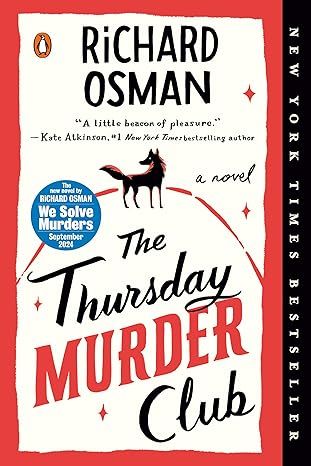
The Thursday Murder Club: A Novel (A Thursday Murder Club Mystery)
4.3
-
155,575
$6.33

Sapiens: A Brief History of Humankind
4.6
-
140,302
$13.49

The Butterfly Garden (The Collector, 1)
4.3
-
88,556
$9.59

Things We Hide from the Light (Knockemout Series, 2)
4.4
-
94,890
$11.66
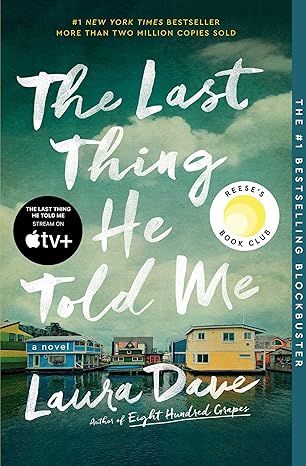
The Last Thing He Told Me: A Novel
4.3
-
154,085
$2.99

The Perfect Marriage: A Completely Gripping Psychological Suspense
4.3
-
143,196
$9.47

The Coworker
4.1
-
80,003
$13.48

First Lie Wins: A Novel (Random House Large Print)
4.3
-
54,062
$14.99

Mile High (Windy City Series Book 1)
4.4
-
59,745
$16.19

Layla
4.2
-
107,613
$8.99

The Locked Door
4.4
-
94,673
$8.53
